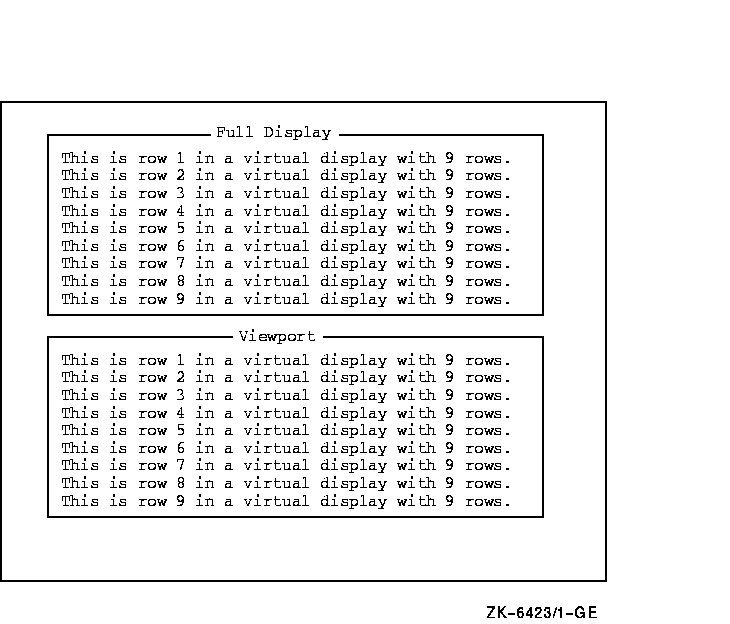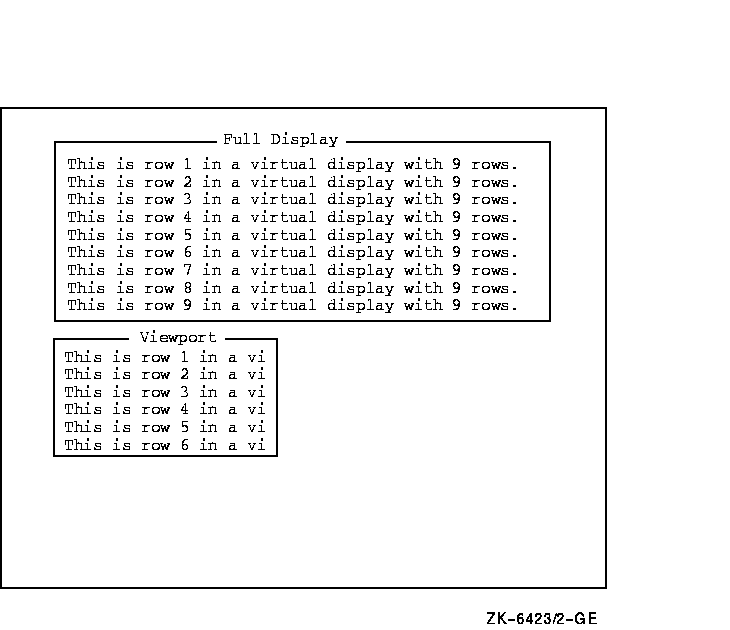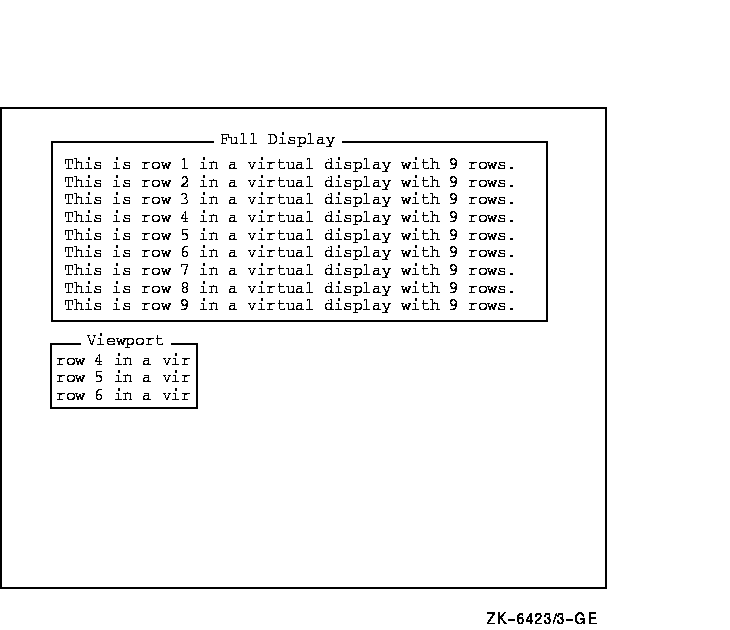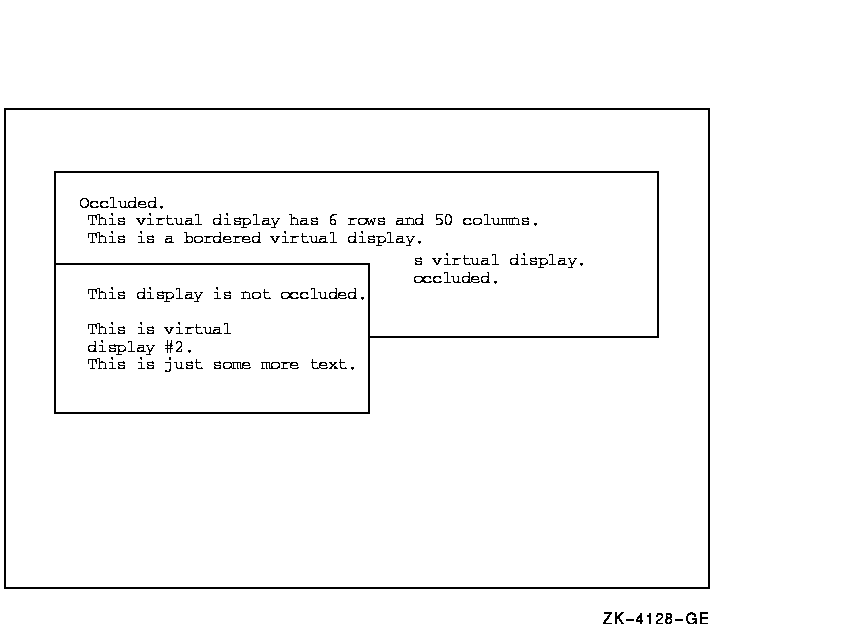 |
OpenVMS RTL Screen Management (SMG$) Manual
SMG$CHANGE_VIEWPORT
The Change the Viewport Associated with a Virtual Display routine
changes the size of an existing viewport in a virtual display. The text
currently in the viewport is remapped to fit the new dimensions.
Format
SMG$CHANGE_VIEWPORT display-id [,viewport-row-start]
[,viewport-column-start] [,viewport-number-rows]
[,viewport-number-columns]
RETURNS
| OpenVMS usage: |
cond_value |
| type: |
longword (unsigned) |
| access: |
write only |
| mechanism: |
by value |
Arguments
display-id
| OpenVMS usage: |
identifier |
| type: |
longword (unsigned) |
| access: |
read only |
| mechanism: |
by reference |
Identifier of the virtual display containing the viewport to be
changed. The display-id argument is the address of an
unsigned longword containing this identifier.
viewport-row-start
| OpenVMS usage: |
longword_signed |
| type: |
longword (signed) |
| access: |
read only |
| mechanism: |
by reference |
Optional row number in the virtual display that will become row 1 in
the changed viewport. The viewport-row-start argument
is the address of a signed longword containing the row number. If
omitted, the present viewport-row-start value is used.
viewport-column-start
| OpenVMS usage: |
longword_signed |
| type: |
longword (signed) |
| access: |
read only |
| mechanism: |
by reference |
Optional column number in the virtual display that will become column 1
in the changed viewport. The viewport-column-start
argument is the address of a signed longword containing the column
number. If omitted, the present viewport-column-start
value is used.
viewport-number-rows
| OpenVMS usage: |
longword_signed |
| type: |
longword (signed) |
| access: |
read only |
| mechanism: |
by reference |
Optional number of rows in the changed viewport. The
viewport-number-rows argument is the address of a
signed longword containing the number of rows. If omitted, the present
viewport-number-rows value is used.
viewport-number-columns
| OpenVMS usage: |
longword_signed |
| type: |
longword (signed) |
| access: |
read only |
| mechanism: |
by reference |
Optional number of columns in the changed viewport. The
viewport-number-columns argument is the address of a
signed longword containing the number of columns. If omitted, the
present viewport-number-columns value is used.
Description
SMG$CHANGE_VIEWPORT lets you change the size of an existing viewport in
a virtual display. The text currently in this viewport is remapped to
fit the new dimensions, starting at the position specified by the
viewport-row-start and
viewport-column-start arguments. This position also
specifies the resulting virtual cursor location.
Condition Values Returned
|
SS$_NORMAL
|
Normal successful completion.
|
|
SMG$_INVARG
|
Number of rows or columns is less than zero.
|
|
SMG$_INVCOL
|
Invalid column specified.
|
|
SMG$_INVDIS_ID
|
Invalid
display-id.
|
|
SMG$_INVROW
|
Invalid row specified.
|
|
SMG$_NO_WINASSOC
|
No viewport associated with the virtual display.
|
|
SMG$_WRONUMARG
|
Wrong number of arguments.
|
Example
|
C+
C This Fortran example program demonstrates the use of
C SMG$CHANGE_VIEWPORT.
C-
IMPLICIT INTEGER (A-Z)
INCLUDE '($SMGDEF)'
C Create the virtual display. Give it a border.
ROWS = 9
COLUMNS = 50
STATUS = SMG$CREATE_VIRTUAL_DISPLAY
1 (ROWS, COLUMNS, DISPLAY1,SMG$M_BORDER )
IF (.NOT. STATUS) CALL LIB$SIGNAL(%val(STATUS))
C Create the pasteboard.
STATUS = SMG$CREATE_PASTEBOARD (PASTE1)
IF (.NOT. STATUS) CALL LIB$SIGNAL(%val(STATUS))
C Put data in the virtual display.
STATUS = SMG$PUT_CHARS ( DISPLAY1,
1 'This is row 1 in a virtual display with 9 rows.',1,1)
IF (.not. STATUS) CALL LIB$SIGNAL(%val(STATUS))
STATUS = SMG$PUT_CHARS ( DISPLAY1,
1 'This is row 2 in a virtual display with 9 rows.',2,1)
IF (.not. STATUS) CALL LIB$SIGNAL(%val(STATUS))
STATUS = SMG$PUT_CHARS ( DISPLAY1,
1 'This is row 3 in a virtual display with 9 rows.',3,1)
IF (.not. STATUS) CALL LIB$SIGNAL(%val(STATUS))
STATUS = SMG$PUT_CHARS ( DISPLAY1,
1 'This is row 4 in a virtual display with 9 rows.',4,1)
IF (.not. STATUS) CALL LIB$SIGNAL(%val(STATUS))
STATUS = SMG$PUT_CHARS ( DISPLAY1,
1 'This is row 5 in a virtual display with 9 rows.',5,1)
IF (.not. STATUS) CALL LIB$SIGNAL(%val(STATUS))
STATUS = SMG$PUT_CHARS ( DISPLAY1,
1 'This is row 6 in a virtual display with 9 rows.',6,1)
IF (.not. STATUS) CALL LIB$SIGNAL(%val(STATUS))
STATUS = SMG$PUT_CHARS ( DISPLAY1,
1 'This is row 7 in a virtual display with 9 rows.',7,1)
IF (.not. STATUS) CALL LIB$SIGNAL(%val(STATUS))
STATUS = SMG$PUT_CHARS ( DISPLAY1,
1 'This is row 8 in a virtual display with 9 rows.',8,1)
IF (.not. STATUS) CALL LIB$SIGNAL(%val(STATUS))
STATUS = SMG$PUT_CHARS ( DISPLAY1,
1 'This is row 9 in a virtual display with 9 rows.',9,1)
IF (.not. STATUS) CALL LIB$SIGNAL(%val(STATUS))
C Paste the virtual display.
STATUS = SMG$COPY_VIRTUAL_DISPLAY(DISPLAY1,DISPLAY2)
IF (.NOT. STATUS) CALL LIB$SIGNAL(%VAL(STATUS))
STATUS = SMG$LABEL_BORDER (DISPLAY1, 'Full Display',,,SMG$M_BOLD)
IF (.NOT. STATUS) CALL LIB$SIGNAL(%VAL(STATUS))
STATUS = SMG$LABEL_BORDER (DISPLAY2, 'Viewport',,,SMG$M_BOLD)
IF (.NOT. STATUS) CALL LIB$SIGNAL(%VAL(STATUS))
STATUS = SMG$PASTE_VIRTUAL_DISPLAY ( DISPLAY1, PASTE1, 2, 10)
IF (.NOT. STATUS) CALL LIB$SIGNAL(%VAL(STATUS))
STATUS = SMG$PASTE_VIRTUAL_DISPLAY ( DISPLAY2, PASTE1, 13, 10)
IF (.NOT. STATUS) CALL LIB$SIGNAL(%VAL(STATUS))
CALL LIB$WAIT (4.0)
STATUS = SMG$CREATE_VIEWPORT ( DISPLAY2, 2, 1, 5, 21)
IF (.NOT. STATUS) CALL LIB$SIGNAL(%VAL(STATUS))
CALL LIB$WAIT (4.0)
STATUS = SMG$PASTE_VIRTUAL_DISPLAY ( DISPLAY2, PASTE1, 13, 10)
IF (.NOT. STATUS) CALL LIB$SIGNAL(%VAL(STATUS))
CALL LIB$WAIT (4.0)
STATUS = SMG$CHANGE_VIEWPORT ( DISPLAY2, 4, 8, 3, 15)
IF (.NOT. STATUS) CALL LIB$SIGNAL(%VAL(STATUS))
call lib$wait (4.0)
END
|
The output generated by this Fortran example is shown in the following
figures. In Figure SMG-1, the program has copied the initial virtual
display into a second virtual display, labeled "Viewport."
Figure SMG-1 Output Generated After Virtual Displays Are
Pasted

After the two identical virtual displays are pasted, the program
creates a viewport on the second (copy) virtual display. Once the
second display is "repasted," only the portion located in the
viewport is visible. This is shown in Figure SMG-2.
Figure SMG-2 Output Generated After the Viewport Is
Created

By calling SMG$CHANGE_VIEWPORT, the portion of the virtual display that
is visible through the viewport is changed. This is shown in
Figure SMG-3.
Figure SMG-3 Output Generated After Calling
SMG$CHANGE_VIEWPORT

SMG$CHANGE_VIRTUAL_DISPLAY
The Change Virtual Display routine lets you change the dimensions,
border, and video attributes of a virtual display.
Format
SMG$CHANGE_VIRTUAL_DISPLAY display-id [,number-of-rows]
[,number-of-columns] [,display-attributes] [,video-attributes]
[,character-set]
RETURNS
| OpenVMS usage: |
cond_value |
| type: |
longword (unsigned) |
| access: |
write only |
| mechanism: |
by value |
Arguments
display-id
| OpenVMS usage: |
identifier |
| type: |
longword (unsigned) |
| access: |
read only |
| mechanism: |
by reference |
Specifies the virtual display whose attributes are to be changed. The
display-id argument is the address of an unsigned
longword that contains the display identifier.
The display identifier is returned by SMG$CREATE_VIRTUAL_DISPLAY.
number-of-rows
| OpenVMS usage: |
longword_signed |
| type: |
longword (signed) |
| access: |
read only |
| mechanism: |
by reference |
Specifies the new number of rows for the virtual display. The
number-of-rows argument is the address of a signed
longword that contains the number of rows in the virtual display.
number-of-columns
| OpenVMS usage: |
longword_signed |
| type: |
longword (signed) |
| access: |
read only |
| mechanism: |
by reference |
Specifies the new number of columns for the virtual display. The
number-of-columns argument is the address of a signed
longword that contains the number of columns in the virtual display.
display-attributes
| OpenVMS usage: |
mask_longword |
| type: |
longword (unsigned) |
| access: |
read only |
| mechanism: |
by reference |
Specifies the attributes of the virtual display. The
display-attributes argument is the address of a
longword bit mask that contains the display attributes.
Valid values for display-attributes are as follows:
|
SMG$M_BORDER
|
Specifies a bordered display. If omitted, the display is not bordered.
|
|
SMG$M_BLOCK_BORDER
|
Specifies a block bordered display. If omitted, the display is not
bordered.
|
|
SMG$M_DISPLAY_CONTROLS
|
Specifies that control characters such as carriage return and line feed
are displayed as graphic characters, if your terminal supports them.
|
|
SMG$M_TRUNC_ICON
|
Specifies that an icon (generally a diamond shape) is displayed where
truncation of a line exceeding the width of the virtual display has
occurred.
|
video-attributes
| OpenVMS usage: |
mask_longword |
| type: |
longword (unsigned) |
| access: |
read only |
| mechanism: |
by reference |
Specifies the default rendition to be applied to all output in a
virtual display, unless overridden by a call to a specific output
routine. The video-attributes argument is the address
of an unsigned longword that contains the video attributes mask.
For example, a call to SMG$PUT_CHARS with an explicit rendition
specified would override the default rendition.
The bits that can be set for this argument are as follows:
|
SMG$M_BLINK
|
Displays blinking characters.
|
|
SMG$M_BOLD
|
Displays characters in higher-than-normal intensity.
|
|
SMG$M_REVERSE
|
Displays characters in reverse video; that is, to the opposite of the
current default rendition of the virtual display.
|
|
SMG$M_UNDERLINE
|
Displays underlined characters.
|
|
SMG$M_INVISIBLE
|
Specifies invisible characters; that is, the characters exist in the
virtual display but do not appear on the pasteboard.
|
SMG$M_USER1 through
SMG$M_USER8
|
Displays user-defined attributes.
|
You can specify any combination of attributes in a single call. All
other bits are reserved for use by Compaq and must be 0.
character-set
| OpenVMS usage: |
longword_unsigned |
| type: |
longword (unsigned) |
| access: |
read only |
| mechanism: |
by reference |
Specifies the default character set for all text in this virtual
display. The character-set argument is the address of
an unsigned longword that contains the character set specifier. Valid
values are SMG$C_ASCII (the default), and SMG$C_SPEC_GRAPHICS.
Description
SMG$CHANGE_VIRTUAL_DISPLAY lets you change the size or default
attributes of an existing virtual display. If the size of the virtual
display is changed, the Screen Management Facility attempts to remap
the text associated with the display to fit the new dimensions
(starting at row 1 and column 1). If the new size of the virtual
display is smaller than the old size, text may be truncated. If the new
size of the virtual display is larger than the old size, text may be
padded on the right with spaces.
When a display is redimensioned, the virtual cursor for the display is
moved to row 1 and column 1. If a labeled border applies to the virtual
display and does not fit the redimensioned display, the label is
deleted.
If a program calls both SMG$CREATE_PASTEBOARD and
SMG$CREATE_VIRTUAL_KEYBOARD, make sure SMG$CREATE_PASTEBOARD is called
first. The program will not function correctly if
SMG$CREATE_VIRTUAL_KEYBOARD is called before SMG$CREATE_PASTEBOARD.
Condition Values Returned
|
SS$_NORMAL
|
Normal successful completion.
|
|
LIB$_INSVIRMEM
|
Insufficient virtual memory to reallocate needed buffers.
|
|
SMG$_INVARG
|
Invalid video or display attributes.
|
|
SMG$_INVDIS_ID
|
Invalid
display-id.
|
|
SMG$_WRONUMARG
|
Wrong number of arguments.
|
SMG$CHECK_FOR_OCCLUSION
The Check for Occlusion routine checks to see whether a virtual display
is covered (occluded) by another virtual display.
Format
SMG$CHECK_FOR_OCCLUSION display-id ,pasteboard-id ,occlusion-state
RETURNS
| OpenVMS usage: |
cond_value |
| type: |
longword (unsigned) |
| access: |
write only |
| mechanism: |
by value |
Arguments
display-id
| OpenVMS usage: |
identifier |
| type: |
longword (unsigned) |
| access: |
read only |
| mechanism: |
by reference |
Specifies the virtual display to be checked. The
display-id argument is the address of an unsigned
longword that contains the display identifier.
The display identifier is returned by SMG$CREATE_VIRTUAL_DISPLAY.
pasteboard-id
| OpenVMS usage: |
identifier |
| type: |
longword (unsigned) |
| access: |
read only |
| mechanism: |
by reference |
Specifies the pasteboard to be checked. The
pasteboard-id argument is the address of an unsigned
longword that contains the pasteboard identifier.
The pasteboard identifier is returned by SMG$CREATE_PASTEBOARD.
occlusion-state
| OpenVMS usage: |
longword_signed |
| type: |
longword (signed) |
| access: |
write only |
| mechanism: |
by reference |
Receives the value denoting whether the display is occluded. The
occlusion-state argument is the address of a signed
longword into which the occlusion state is written.
Occlusion-state is set to 1 if the display is occluded
or set to 0 if the display is not occluded on the specified pasteboard.
If the procedure does not return SS$_NORMAL, the contents of
occlusion-state are undefined.
Description
SMG$CHECK_FOR_OCCLUSION determines whether a specified virtual display
as pasted to the specified pasteboard is occluded, or covered, by
another virtual display.
Condition Values Returned
|
SS$_NORMAL
|
Normal successful completion.
|
|
SMG$_INVDIS_ID
|
Invalid
display-id.
|
|
SMG$_INVPAS_ID
|
Invalid
pasteboard-id.
|
|
SMG$_NOTPASTED
|
Specified virtual display is not pasted to the specified pasteboard.
|
|
SMG$_WRONUMARG
|
Wrong number of arguments.
|
Example
|
C+
C This Fortran example program demonstrates the use of
C SMG$CHECK_FOR_OCCLUSION.
C
C This routine creates a virtual display and writes it to the
C pasteboard. Data is placed in the virtual display using SMG$PUT_CHARS.
C-
INTEGER SMG$CREATE_VIRTUAL_DISPLAY, SMG$CREATE_PASTEBOARD
INTEGER SMG$PASTE_VIRTUAL_DISPLAY, SMG$PUT_CHARS
INTEGER SMG$CHECK_FOR_OCCLUSION
INTEGER DISPLAY1, DISPLAY2, PASTE1, PASTE2, ROWS, COLUMNS, BORDER
INTEGER OCCLUSION, STATUS
CHARACTER*29 TEXT
C+
C Include the SMG definitions. In particular, we want SMG$M_BORDER.
C-
INCLUDE '($SMGDEF)'
C+
C Create two virtual displays using SMG$CREATE_VIRTUAL_DISPLAY.
C Give them borders.
C-
ROWS = 6
COLUMNS = 50
STATUS = SMG$CREATE_VIRTUAL_DISPLAY
1 (ROWS, COLUMNS, DISPLAY1, SMG$M_BORDER)
IF (.NOT. STATUS) CALL LIB$SIGNAL(%VAL(STATUS))
ROWS = 5
COLUMNS = 30
STATUS = SMG$CREATE_VIRTUAL_DISPLAY
1 (ROWS, COLUMNS, DISPLAY2, SMG$M_BORDER)
IF (.NOT. STATUS) CALL LIB$SIGNAL(%VAL(STATUS))
C+
C Create the pasteboard using SMG$CREATE_PASTEBOARD.
C-
STATUS = SMG$CREATE_PASTEBOARD (PASTE1)
IF (.NOT. STATUS) CALL LIB$SIGNAL(%VAL(STATUS))
C+
C Use SMG$PUT_CHARS to put data into the virtual displays.
C-
STATUS = SMG$PUT_CHARS ( DISPLAY1,
1 ' This virtual display has 6 rows and 50 columns.', 2, 1)
IF (.NOT. STATUS) CALL LIB$SIGNAL(%VAL(STATUS))
STATUS = SMG$PUT_CHARS ( DISPLAY1,
1 ' This is a bordered virtual display.', 3, 1)
IF (.NOT. STATUS) CALL LIB$SIGNAL(%VAL(STATUS))
STATUS = SMG$PUT_CHARS ( DISPLAY1,
1 ' SMG$PUT_CHARS puts data in this virtual display.', 4,
1 1)
IF (.NOT. STATUS) CALL LIB$SIGNAL(%VAL(STATUS))
STATUS = SMG$PUT_CHARS ( DISPLAY1,
1 ' This text should be partially occluded.', 5, 1)
IF (.NOT. STATUS) CALL LIB$SIGNAL(%VAL(STATUS))
STATUS = SMG$PUT_CHARS ( DISPLAY1,
1 ' So should part of this row.', 6, 1)
IF (.NOT. STATUS) CALL LIB$SIGNAL(%VAL(STATUS))
STATUS = SMG$PUT_CHARS ( DISPLAY2, ' This is virtual', 3, 1)
IF (.NOT. STATUS) CALL LIB$SIGNAL(%VAL(STATUS))
STATUS = SMG$PUT_CHARS ( DISPLAY2,
1 ' display #2.', 4, 1)
IF (.NOT. STATUS) CALL LIB$SIGNAL(%VAL(STATUS))
STATUS = SMG$PUT_CHARS ( DISPLAY2,
1 ' This is just some more text.', 5, 1)
IF (.NOT. STATUS) CALL LIB$SIGNAL(%VAL(STATUS))
C+
C Use SMG$PASTE_VIRTUAL_DISPLAY to paste the virtual display.
C-
STATUS = SMG$PASTE_VIRTUAL_DISPLAY ( DISPLAY1, PASTE1, 4, 15)
IF (.NOT. STATUS) CALL LIB$SIGNAL(%VAL(STATUS))
STATUS = SMG$PASTE_VIRTUAL_DISPLAY ( DISPLAY2, PASTE1, 8, 15)
IF (.NOT. STATUS) CALL LIB$SIGNAL(%VAL(STATUS))
C+
C Check the two virtual displays for occlusion by calling
C SMG$CHECK_FOR_OCCLUSION.
C-
TEXT = 'This display is not occluded.'
STATUS = SMG$CHECK_FOR_OCCLUSION (DISPLAY1, PASTE1, OCCLUSION)
IF (.NOT. STATUS) CALL LIB$SIGNAL(%VAL(STATUS))
IF (OCCLUSION .EQ. 0) THEN
STATUS = SMG$PUT_CHARS (DISPLAY1, TEXT, 1, 1)
IF (.NOT. STATUS) CALL LIB$SIGNAL(%VAL(STATUS))
ELSE
STATUS = SMG$PUT_CHARS (DISPLAY1, 'Occluded.', 1 , 1)
IF (.NOT. STATUS) CALL LIB$SIGNAL(%VAL(STATUS))
END IF
STATUS = SMG$CHECK_FOR_OCCLUSION (DISPLAY2, PASTE1, OCCLUSION)
IF (.NOT. STATUS) CALL LIB$SIGNAL(%VAL(STATUS))
IF (OCCLUSION .EQ. 0) THEN
STATUS = SMG$PUT_CHARS (DISPLAY2, TEXT, 1, 1)
IF (.NOT. STATUS) CALL LIB$SIGNAL(%VAL(STATUS))
ELSE
STATUS = SMG$PUT_CHARS (DISPLAY2, 'Occluded.', 1 , 1)
IF (.NOT. STATUS) CALL LIB$SIGNAL(%VAL(STATUS))
END IF
END
|
The output generated by this Fortran program is shown in Figure SMG-4.
Figure SMG-4 Output Generated by Fortran Program Calling
SMG$CHECK_FOR_OCCLUSION

|



